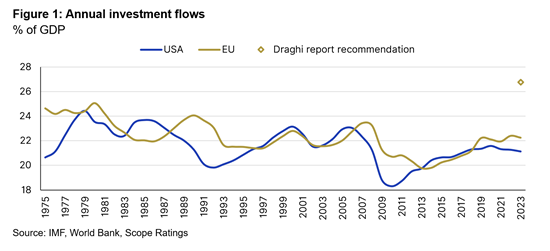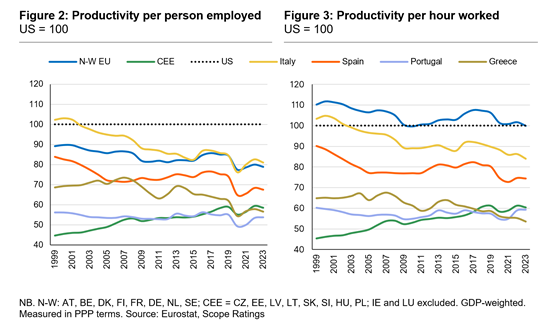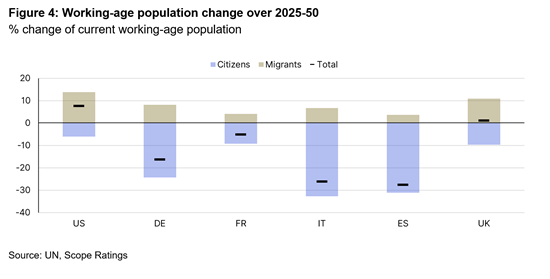Announcements
Drinks
The Draghi report: political stalemate and Europe’s productivity gap curb growth outlook
Alvise Lennkh-Yunus and Brian Marly, Sovereign & Public Sector
The recent report by former Italian Prime Ministers Mario Draghi on Europe’s future competitiveness, emphasizes the urgency of structural reforms to bolster Europe’s growth and reverse its slow productivity growth of the past 20 years.
Europe faces a range of challenges including widening gaps in technology and digital infrastructure, a fragmented single and capital market, a declining working-age population, and the need to balance decarbonisation with competitiveness goals while ensuring Europe’s security given volatile geopolitics.
Addressing these challenges ultimately requires greater cooperation at the European level on fiscal, trade, energy and foreign policies coupled with significant private and public investments, including joint funding. The Draghi report estimates additional annual investment needs of around EUR 750-800bn, or about 4.5% of EU-27 GDP (Figure 1). The primary challenge remains funding these additional investments, as European policymakers are still divided over how much responsibility should be allocated between national and EU levels.

Populist parties drive political uncertainty in France and Germany hindering growth prospects
Europe’s medium-term growth outlook, projected at around 1.0-1.5%, is below the 2.0% estimated for the US. The reforms outlined by Draghi could narrow this gap, but advancing EU integration as he proposes faces opposition from populist and extreme parties with nationalist agendas.
In France (AA/Negative), three months after the snap elections in July, it is still unclear whether the new prime minister can form a stable government capable of materially reducing the budget deficit and enacting major supply-side reforms to boost economic growth.
It is also unlikely that France’s next government, which will be primarily reliant on the far right, will be an advocate for policies deepening European integration ahead of the presidential elections scheduled for 2027.
Similarly, in Germany (AAA/Stable), the recent success of populist far-right and far-left parties in Thuringia and Saxony highlights Germany’s fragmenting political landscape. As mainstream parties lose ground, the current traffic-light coalition government is weakened, reducing the likelihood of further economic stimulus and reforms.
Moreover, with general elections scheduled for October 2025, it is unlikely that the mainstream parties will reform the debt-brake rule – which requires a two-thirds majority and support from the conservative opposition. This political inertia also makes further European-level reforms difficult even though they are essential to boost investment and growth in Germany and Europe.
Europe’s divergent productivity reflects different stages of economic development
Similarly, raising Europe’s growth outlook will require Southern Europe to address its productivity gap, particularly when compared with the US – per capita and per hour worked – over the past 25 years (Figure 2). Full and timely implementation of the Next Generation EU reforms and investments until 2026, especially in Italy (BBB+/Stable) and Spain (A/Stable), are thus critical.
The productivity gap between North-West European employees to US employees has also increased to 20% in 2023 from 10% in 1999 when the euro was introduced. However, this gap is erased once accounted for total hours worked (Figure 3). This suggests that in North-Western Europe the issue is less individual productivity, but rather fewer hours worked compared with the US. One or the other, if not both, need to improve to raise Europe’s growth outlook, which is possible as shown by Central and Eastern Europe where the productivity gap to the US has narrowed over the past 25 years.
Productivity gains and migration inflows critical given adverse demographic trends
Both the US and EU are facing a declining working age population based on their citizens, but the projected net inflow of migrants to the US over the next 25 years will result in an increasing working-age population. This contrasts with Europe, where the number of migrants is not enough to compensate for the natural decline of the working-age population, especially in Germany, Italy and Spain (Figure 4). This demographic shift underscores the growing importance of productivity gains as a driver of economic growth compared with previous decades. Unless Europe significantly enhances its capacity to attract and integrate foreign workers, productivity improvements will be critical for sustaining growth.









